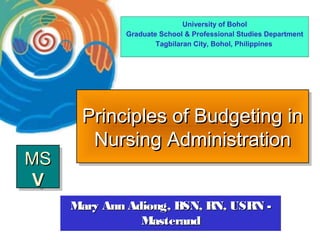
Budgeting Principles in Nursing Administration
- 1. University of Bohol Graduate School & Professional Studies Department Tagbilaran City, Bohol, Philippines MS MS V V Principles of Budgeting in Principles of Budgeting in Nursing Administration Nursing Administration Mary Ann Adiong, BSN, RN, USRN Masterand
- 2. DEFINITION DEFINITION • A forecast of the resources required to deliver the services offered by the organization. • A budget is a financial plan that includes estimated expenses as well as income for a period of time. • A nursing budget is a systematic plan that is informed best estimate by nurse administrators of nursing revenues and expenses. It projects how revenues will meet expenses and projects a return on equity or profit.
- 3. PURPOSE PURPOSE To plan the objectives, programs and activities of nursing services and the fiscal resources to accomplish them. To motivate nurse managers and nursing workers through analysis of actual experiences. To evaluate the performance of nurse administrators and managers and increase awareness of the costs.
- 6. IMPORTANCE OF BUDGET IMPORTANCE OF BUDGET An essential management tool Budget tells you how much money you need to carry out your activities Budget enables to monitor income and expenditure. The budget is basis for financial accountability and transparency.
- 13. TYPES OF BUDGET TYPES OF BUDGET
- 15. OPERATING BUDGET OPERATING BUDGET It provides an overview of an agency’s functions by projecting the planned operations usually for the upcoming year. The nurse manager might includes personnel salaries, employee benefits, insurance, medicalsurgical supplies, office supplies, rent, heat, light and house keeping
- 16. CASH BUDGET CASH BUDGET Cash budget are planned to make adequate funds available as needed and to use any extra funds profitably. The ensure that the agency has enough, but not too much, cash on hand during the budgetary period.
- 17. PERSONNEL BUDGET PERSONNEL BUDGET Estimates the cost of direct labor necessary to meet the nursing needs of the estimated patient population. It includes recruitment, hiring, assignment, lay off and discharge of personnel. The current staffing patterns, number of unfilled positions and last year’s report can provide a base.
- 18. 136 = 5.44 25
- 19. BUDGETING APPROACHES BUDGETING APPROACHES INCREMENTAL Budget for the coming year is projected Requires little budget expertise from the part of the manager. Advantages: Simple to prepare and understand Consistent basis Better coordination between budgets Disadvantages: Totally ignore the impact of changes No incentive in development and innovation Encourages spending up to the budget This approach is not recommended as it fails to take into account changing circumstances.
- 20. ZERO-BASED BUDGETING ZERO-BASED BUDGETING Assumes the base for projecting next year’s budget is zero. Managers are required to justify all activities and programs as if they initiated for the first time. Every proposed expenditure must be justified with: current environment fit with organizational objectives Since all the costs are required to be justified, it seems inappropriate to use ZBB for the whole budgeting process. One way of overcoming this drawback is to use this method selectively.
- 21. ZERO-BASED BUDGETING ZERO-BASED BUDGETING ADVANTAGES: Efficient allocation of resources Drives managers to find cost reduction methods Identifies and eliminates wasteful activities DISADVANTAGES: Very complex Time and manpower consuming Necessary to train employees, especially managers In a relatively large corporation, the amount of information might be too excessive to go through all. Compressing the information might take out critical details Can result in internal conflicts between departments over budget allocation.
- 22. FLEXIBLE BUDGETING FLEXIBLE BUDGETING are budgets that adjust automatically over the course of the year depending on the variables such as the volumes, labor cost and capital expenditures. automatically calculates what expenses should be given the volume what is occurring thus the costs can be allocated on a volume basis. ADVANTAGES: DISADVANTAGES: 1. Adjustment for Predictions 1. Continuous Monitoring 2. Adapting Change 2. Lack of Information 3. Control and Evaluation 3. Complexity
- 23. PERFORMANCE BUDGETING PERFORMANCE BUDGETING Focuses on the activities of a cost center such as indirect care, direct care and quality monitoring. Each activity has objectives with specific financial resources; performance budgeting focuses on what is expected to be accomplished. Performance budgeting is an improvement over flexible budgeting because it ties performance to consumption of financial resources. STEPS OF PERFORMANCE BUDGETING: 1. Define the performance activities or areas of accomplishment for the cost center. 2. Identify the line-item operating budget for the cost center being evaluated. 3. Define how much of the resources presented by each line item are to be devoted to each performance areas. 4. Choose measures of performance for each performance area, budget an amount of work for each area and determine the budgeted cost-per-unit of work based on these measures.
- 24. PERFORMANCE BUDGET SAMPLE PERFORMANCE BUDGET SAMPLE
